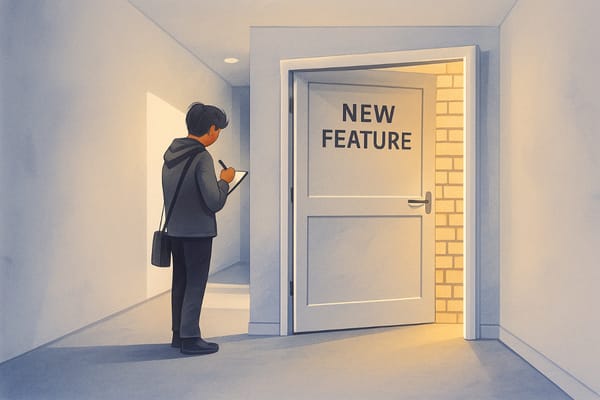Stop Building Wedding Cakes. Ship Cupcakes Instead!

If I asked you about your plans this weekend, you’d probably tell me exactly which cafe you’re heading to, which book you’re catching up on, or which friend group you’re meeting.
But if I asked about the weekend three weeks from now, you’d be less sure, right?
The farther away something is, the harder it is to predict. That’s just how time works (until we figure out time travel). It’s not the passage of time that causes uncertainty, it’s the unforeseen events that sneak in along the way.
This principle applies beautifully to Product Development too.
A product has a lot of moving parts that come together to create the right experience. These moving parts make everything complicated, slow and unpredictable. Add in multiple dimensions like competitive insights, shigting market trends, partnerships, customer feedback, product strategy, analytics, technical challenges and working with uncertainty basically becomes part of the job description.
So much so that by the time all the requirements are identified, the team loses momentum, the idea becomes stale, or the strategy itself changes.
Sometimes adding a single feature to a product starkly resembles planning a wedding. Everyone has opinions, the list keeps growing, and just when you think you’re done, something new gets added to the mix. Except in product development, as soon as you’re done with one wedding, you have to start planning the next.
And we all know what happens when your big plan doesn’t pan out?

Build Fewer Parts
The Agile Manifesto advocates for early, frequent, and continuous delivery of software. But with so many moving parts, how do we ensure smooth progress while still delivering value frequently?
Here’s a simple idea:
Build fewer parts.
Sounds obvious, right? But “Build Fewer Parts” is not about doing less work. It’s about focusing your effort on the right parts. The ones that drive the highest return on effort, learning, and impact.
Let’s break it down.
BUILD - Define what’s truly worth building
Before you start sketching wireframes or writing code, step back and ask:
- What problem are we solving?
- Who exactly are we solving it for?
Decompose your end goal into clear capabilities, not features.
The goal isn’t to ship more; it’s to build something that answers one critical user or business question at a time.
When you define your “why” early, you prevent waste later, saving both time and agile iteration cost.
FEWER - Reduce the surface area of uncertainty
Every iteration is an experiment. The trick is to reduce how many questions you’re asking at once.
- Can you narrow your audience?
- Can you delay a dependency?
- Can you ship half the capability to learn twice as fast?
Each cut you make simplifies the problem and sharpens the insight you’ll get back.
This is where your ROI metric lives, not in the number of features delivered, but in the cost of iteration.
The smaller the iteration, the cheaper the learning.
PARTS - Treat every deliverable as a testable unit
Each “part” of your project is an independent hypothesis—small enough to build, ship, and measure on its own.
By breaking your product into testable parts, you do two things:
- Reduce risk by limiting the blast radius if something fails.
- Increase learning speed by creating multiple short feedback loops instead of one long one.
That’s your cost of iteration in action.
Measuring the ROI of Smaller Iterations
Let’s turn that idea into numbers.
Imagine you’re leading an 8 week project with a team of six people. Assuming an average weekly salary of $2,000 per person (~100k per year):
6 × $2,000 × 8 weeks = $96,000
Now, split that large project into four 2 week iterations:
6 × $2,000 × 2 weeks = $24,000 per iteration
That $24K becomes your Cost per Iteration - your real ROI benchmark.
If the first 2-week cycle fails to hit the mark, you’ve lost $24K, not $96K.
If it succeeds, you’ve learned something valuable for just a quarter of the price.
Iteration turns big bets into small, affordable experiments. It’s the simplest way to reduce cost and ship faster without burning the roadmap.
The Trade-off
Of course, every approach has its downsides.
Breaking a complex project into smaller pieces can cause integration headaches or make the end goal blurry for engineering or business stakeholders.
That’s why you approach these sub-projects with an experimentation mindset.
Every iteration has to prove its worth to stay in the product. If it doesn’t, roll it back, remove it, or rethink it.
Small product releases are like checkpoints. They keep you close to reality instead of lost in strategy.
The Payoff
The advantages of breaking down a project far outweigh the cons. When teams build fewer parts, they:
- Reduce risk through smaller, safer launches.
- Lower iteration cost while improving learning velocity.
- Align closer to market needs through faster feedback.
- Keep momentum alive by turning uncertainty into discovery.
This approach ensures your team can respond more flexibly and effectively to challenges, turning uncertainty into learning, and learning into progress.
Conclusion
Mastering the art of decomposing complex projects into independently deliverable sub-projects is crucial for product teams.
While these sub-projects may build sequentially, the ability to release and evaluate them independently is key.
Like wedding planning, product development is never truly done.
There’s always another celebration waiting. But if you learn to build fewer parts, at least this time, you’ll enjoy the cake.




